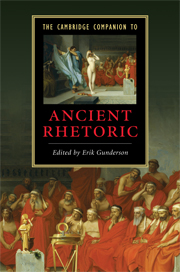Book contents
- Frontmatter
- Introduction
- Part 1 An archaeology of rhetoric
- 1 Fighting words: Status, stature, and verbal contest in archaic poetry
- 2 The philosophy of rhetoric and the rhetoric of philosophy
- 3 Codifications of rhetoric
- Part II The field of language
- Part III The practice of rhetoric
- Part IV Epilogoues
- Appendix 1: Rhetorical terms
- Appendix 2: Authors and prominent individuals
- References
- Index of passages
- Index of subjects
- Series list
3 - Codifications of rhetoric
from Part 1 - An archaeology of rhetoric
Published online by Cambridge University Press: 28 January 2010
- Frontmatter
- Introduction
- Part 1 An archaeology of rhetoric
- 1 Fighting words: Status, stature, and verbal contest in archaic poetry
- 2 The philosophy of rhetoric and the rhetoric of philosophy
- 3 Codifications of rhetoric
- Part II The field of language
- Part III The practice of rhetoric
- Part IV Epilogoues
- Appendix 1: Rhetorical terms
- Appendix 2: Authors and prominent individuals
- References
- Index of passages
- Index of subjects
- Series list
Summary
The classical tradition opens with an epic of war and speech. The fighting in the Iliad is interleaved with talk that decisively influences both its course and its significance to those involved. These two facets of heroic life underlie the syllabus which Peleus prescribed to Achilles’ tutor, Phoenix: “You were a child, with no knowledge yet of leveling war or of debate, where men win distinction. So he sent me out to teach you all these things, to make you a speaker of words and a doer of deeds” (9.440–43). Achilles later acknowledges that he has not learned these two lessons equally well: “I, a man without equal … in war, though there are others better skilled at debate” (18.105f.). He is right: the catastrophic consequences of his mishandling of the assembly in book 1 show why skilled speech was important. It is no surprise that Peleus thought this skill worth learning; that he thought it could be taught foreshadows a distinctive feature of later Greco-Roman culture.
The nearest we come to observing Phoenix’s teaching style is in the Embassy, where he gives Achilles specific injunctions (9.486f.); highlights significant features of the situation, contrasting them with hypothetical alternative scenarios (9.515–22); predicts the consequences of particular courses of action (9.602–605); and, above all, draws to his pupil’s notice examples on which to model, positively or negatively, his behavior. He does not rely on explicitly formulated general principles. Likewise in teaching skilled speech, he would not have needed to articulate principles in an abstract general form, let alone to systematize them. Practical skills can be taught by showing the pupil models from which, his attention guided by particularized injunctions and evaluative feedback, he can implicitly assimilate appropriate habits of performance and judgment. But the systematization of explicitly articulated principles for skilled speech was to become another characteristic feature of Greco-Roman culture. This chapter outlines the history of that process, its goals, and its achievements.
- Type
- Chapter
- Information
- The Cambridge Companion to Ancient Rhetoric , pp. 59 - 74Publisher: Cambridge University PressPrint publication year: 2009
- 5
- Cited by

